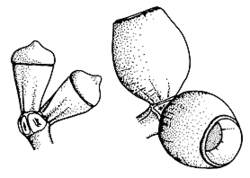Common name: yellow bloodwood
Corymbia eximia (Schauer) K.D.Hill & L.A.S.Johnson APNI* Synonyms: Eucalyptus eximia Schauer APNI*

Description: Tree to 20 m high; bark persistent, pale brown or yellow brown, tessellated or fibrous-flaky.
Juvenile leaves disjunct, ovate or elliptic to broad-lanceolate, dull grey-green. Adult leaves disjunct, lanceolate, 10–20 cm long, 1.3–3 cm wide, green, dull, concolorous.
Conflorescence compound; umbellasters 7-flowered; peduncle terete or angular, 10–30 mm long; pedicels 0–2 mm long. Buds clavate to pyriform, 10–15 mm long, 6–8 mm diam., scar present; calyptra conical, slightly rostrate, shorter than and as wide as hypanthium.
Fruit subsessile, ovoid or urceolate, 13–20 mm long, 10–15 mm diam.; disc depressed; valves enclosed.
Distribution and occurrence: Locally abundant, in dry sclerophyll woodland on shallow infertile soils on sandstone, often on steep slopes; from Howes Valley to Tolwong.
NSW subdivisions: NC, CC, SC
Text by K.D. Hill
Taxon concept:
APNI* Provides a link to the Australian Plant Name Index (hosted by the Australian National Botanic Gardens) for comprehensive bibliographic data
***The AVH map option provides a detailed interactive Australia wide distribution map drawn from collections held by all major Australian herbaria participating in the Australian Virtual Herbarium project.
|


